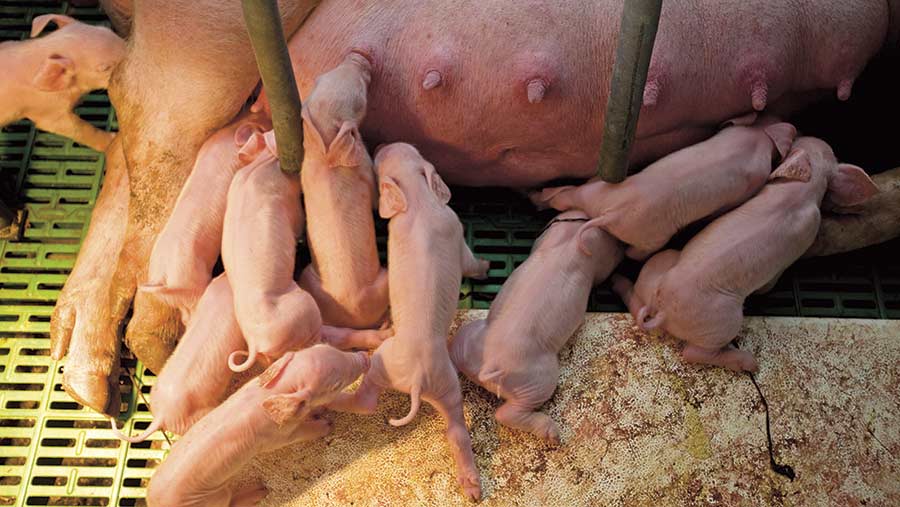How pig breeding technology could help cut disease-related costs
 © Tim Scrivener
© Tim Scrivener Breeding technologies which help pigs become genetically healthier and less susceptible to illness could help the UK pork sector reduce antibiotics use and save millions of pounds every year.
Losses in production thanks to disease, reduced productivity and increased health costs are estimated to cost producers more then £16bn/year globally.
See also: First PRRS resistant pigs bred in scientific breakthrough
However, scientists hope through the development of genomic technologies, breeders will be able to produce animals which are more tolerant to disease risks – helping to slash the costs associated with treating illness and driving down the costs of pig production.
What is genomics?
First developed in the 1990s, genomic technology involves analysing DNA for genomic variations, known as single nucleotide polymorphisms (SNPs), which can be compared against a bank of genetic information to predict the genetic potential of animals.
The technology is most commonly used to help select for desired traits such as back fat, reproductive traits and feed conversion ratios.
But scientists are now making developments in selecting animals which are more likely to withstand illness, handle environmental factors such as heat stress, and in some cases even be resistant to particular diseases.
“There are lots of ways to control disease,” says pig geneticist Max Rothschild of Iowa State University.
“Biosecurity, vaccination and antibiotics are the usual approaches, but selecting animals which are less susceptible to disease is growing in potential.”
Identifying healthy genes
Prof Rothschild says scientists are working on identifying areas of pig genes, which identify greater resistance to diseases including porcine reproductive and respiratory syndrome (PRRS), porcine circovirus (PCV2) and porcine epidemic diarrhoea virus (PEDV).
“Early work in PRRS just looked at breed deficiencies, with scientists discovering that Landrace were more susceptible to the disease, while Pietrain were less susceptible,” he says.
However, scientists have now discovered a point on a chromosome which is associated with pigs being less likely to succumb to the disease.
“They can still get it, but they still grow and reproduce,” he says.
“It means breeding companies can now select for that preferred genotype and limit the risk.”
Similarly with PEDV scientists have found evidence the disease is under genetic control, Prof Rothschild adds.
“The work is in the preliminary stages, but it could eventually be used to breed animals.”
In future, Prof Rothschild says diseases such as PRRS and African swine fever could be essentially “bred out” of pigs, as scientists develop new gene editing technologies which create disease resistance.
Other developments in the technology include looking at the ability of boars to produce stronger offspring.
“We currently use SNP chips as a screening service for genetic abnormality for reproductive problems,” says Darren Griffen, professor of genetics at the University of Kent.
Removing poor-performing boars
“By screening boars we can save breeding companies thousands of pounds by eliminating poor boars from the breeding population.”
In future, however, Prof Griffen and his team are hoping to make use of IVF technology, which will give them the ability to genetically screen embryos rather than live-born animals.
“It means we don’t have to wait for the pigs to be born and waste the ones that aren’t great – we will only transplant the embryos which are good in the first place, and avoid the ones which are likely to get ill,” he says.
“There are logistical issues which make it difficult in pigs, but we hope that in future it will help us produce offspring which we know will be fit, lean, productive and reproductive.”
Breeding caution
Grant Walling, director at JSR Genetics, says UK breeding companies are increasingly taking advantage of promising developments in genomic technology, but he warns the science behind it needs to proceed with caution.
“While it’s possible to alter a specific protein, we don’t know what the function of that protein is elsewhere,” he says.
“We have to make sure than when we change animals and make them resistant that we don’t make them susceptible to something else.
“We have certainly seen evidence that selecting animals with a more active immune system may mean they are directing energy away from key performance indicators, such as growth.
“The other thing to remember is diseases can adapt as quickly as the changes you are making.
“The concept of how we deal with disease in future is still developing and under discussion,” he adds.
“There’s still a long way to of in the thought process and the science – our understanding of disease isn’t good enough yet to wipe it out and change the world tomorrow.”
Prof Rothschild agrees genomic technology is not necessarily the only answer for farmers looking to produce healthier pig herds.
“The most important thing is biosecurity,” he says. “It’s one thing to think about existing diseases, but there will always be new diseases being developed.
“If we want to cut antibiotics use in pig production then we need healthier pigs, but to have healthy pigs we need better biosecurity and healthier environments for those animals to live in.”

